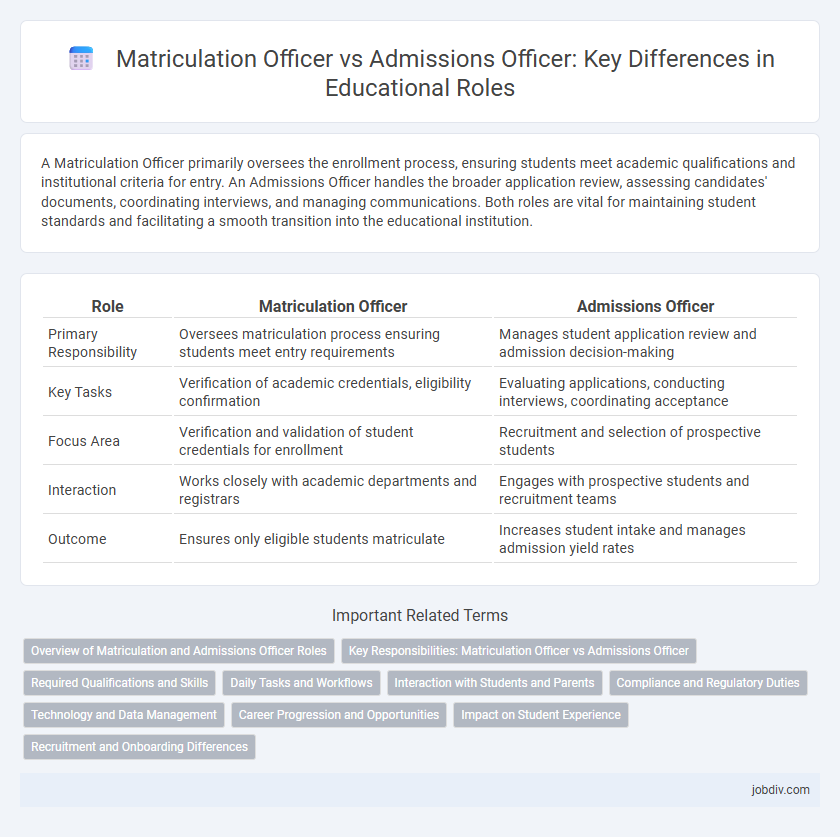A Matriculation Officer primarily oversees the enrollment process, ensuring students meet academic qualifications and institutional criteria for entry. An Admissions Officer handles the broader application review, assessing candidates' documents, coordinating interviews, and managing communications. Both roles are vital for maintaining student standards and facilitating a smooth transition into the educational institution.
Table of Comparison
| Role | Matriculation Officer | Admissions Officer |
|---|---|---|
| Primary Responsibility | Oversees matriculation process ensuring students meet entry requirements | Manages student application review and admission decision-making |
| Key Tasks | Verification of academic credentials, eligibility confirmation | Evaluating applications, conducting interviews, coordinating acceptance |
| Focus Area | Verification and validation of student credentials for enrollment | Recruitment and selection of prospective students |
| Interaction | Works closely with academic departments and registrars | Engages with prospective students and recruitment teams |
| Outcome | Ensures only eligible students matriculate | Increases student intake and manages admission yield rates |
Overview of Matriculation and Admissions Officer Roles
Matriculation Officers primarily manage the verification and documentation of student eligibility and qualifications for enrollment in educational institutions, ensuring compliance with institutional admission standards. Admissions Officers focus on evaluating applications, conducting interviews, and making decisions about student acceptance to various academic programs based on criteria such as academic records, test scores, and extracurricular achievements. Both roles are crucial in shaping student bodies but differ in their operational emphasis, with Matriculation Officers handling eligibility confirmation and Admissions Officers involved in broader applicant assessment and selection processes.
Key Responsibilities: Matriculation Officer vs Admissions Officer
Matriculation Officers primarily oversee the verification and processing of student enrollment documentation to ensure compliance with institutional and regulatory standards. Admissions Officers focus on evaluating applications, conducting interviews, and selecting qualified candidates to meet enrollment targets and diversity goals. Both roles involve coordinating with academic departments but differ in scope, with Matriculation Officers handling post-admission formalities and Admissions Officers managing the pre-admission applicant assessment.
Required Qualifications and Skills
Matriculation Officers typically require a bachelor's degree in education or administration, with strong organizational and record-keeping skills to manage student enrollment and academic progress effectively. Admissions Officers need a background in marketing, communications, or education, combined with excellent interpersonal and evaluative skills to assess applications and recruit prospective students. Both roles demand proficiency in data management systems and a deep understanding of institutional policies.
Daily Tasks and Workflows
Matriculation Officers manage the verification and recording of student qualifications to ensure eligibility for enrollment, coordinating with academic departments to update student records accurately. Admissions Officers handle the application review process, including evaluating prospective student applications, arranging interviews, and communicating admission decisions. Both roles require extensive collaboration with administrative staff and consistent data management using enrollment and student information systems.
Interaction with Students and Parents
Matriculation Officers primarily focus on guiding newly admitted students through orientation and enrollment processes, ensuring a smooth transition into the institution by addressing their academic and administrative queries. Admissions Officers engage with prospective students and parents during recruitment events, campus tours, and application reviews, providing detailed information about programs, entry requirements, and financial aid options. Both roles require strong communication skills, but Matriculation Officers emphasize ongoing support post-admission, while Admissions Officers concentrate on pre-admission engagement.
Compliance and Regulatory Duties
Matriculation Officers ensure students meet academic and regulatory requirements for enrollment by verifying eligibility and maintaining compliance with institutional policies. Admissions Officers manage application processes while adhering to federal, state, and institutional regulations to guarantee fair and legal admissions practices. Both roles require strict oversight of documentation and reporting to comply with education authorities and accreditation bodies.
Technology and Data Management
Matriculation Officers primarily manage student enrollment data and ensure compliance with institutional policies using advanced database systems, streamlining the registration process. Admissions Officers leverage customer relationship management (CRM) software and data analytics to evaluate applicant information, optimize recruitment strategies, and enhance communication with prospective students. Both roles depend heavily on technology-driven data management to improve workflow efficiency and accuracy within educational institutions.
Career Progression and Opportunities
Matriculation Officers primarily manage student enrollment and eligibility verification, gaining in-depth expertise in academic compliance and institutional policies, which can lead to roles in academic administration or registrar offices. Admissions Officers focus on recruiting prospective students and assessing applications, building strong skills in marketing and communication that open pathways to higher-level admissions management or enrollment strategy positions. Both roles offer distinct career progression opportunities within educational institutions, with advancement often depending on specialization in student services or institutional operations.
Impact on Student Experience
The Matriculation Officer primarily ensures that students meet enrollment requirements, directly influencing the quality of the incoming student body and their readiness for academic challenges. The Admissions Officer shapes the student experience by managing the application process, offering guidance, and fostering a welcoming environment that sets the tone for students' initial interaction with the institution. Together, their roles impact student satisfaction, retention rates, and overall academic success by balancing criteria enforcement and personalized support.
Recruitment and Onboarding Differences
Matriculation Officers primarily focus on verifying student qualifications, ensuring eligibility criteria are met for enrollment, and coordinating orientation sessions to facilitate smooth onboarding. Admissions Officers handle the recruitment process by managing application reviews, conducting interviews, and promoting the institution to prospective students to maximize enrollment rates. The recruitment role centers on attracting candidates, while matriculation emphasizes confirming qualifications and integrating new students into the academic environment.
Matriculation Officer vs Admissions Officer Infographic

 jobdiv.com
jobdiv.com